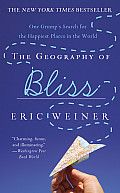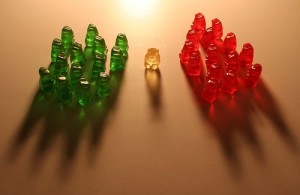 I bought the
The Geography of Bliss
at Powell’s for my nomadic Twin Sis, conveniently for our birthday. She was kind enough to pass it along to me, and I finally finished reading it this past weekend.
I bought the
The Geography of Bliss
at Powell’s for my nomadic Twin Sis, conveniently for our birthday. She was kind enough to pass it along to me, and I finally finished reading it this past weekend.
The author, NPR correspondent Eric Weiner, has a humorous writing style even though it’s research-based non-fiction. Plus, happiness research isn’t exactly the toughest subject to delve into.
Without going into a full review, I would highly recommend the book. He writes about the American trend away from happiness, despite our amassed wealth and stuff. While money is important to have a decent standard of living, research shows that money itself does not make a country or oneself happy.
Without giving away the punchline, it’s no surprise that trust, gratitude and social connections are the genuine bliss breeders. Here’s a brief video where Weiner describes landing in Iceland in the middle January. I reminds me of my Twin Sis’ high school exchange to Finland where she saw the sun once during the entire month of December!
Where is your happiest place?
~*~*~*~*~*~
Sustainable Family Finances
The story of a family creating an abundant and sustainable life.
Category Archives: videos
Healthy Child Healthy World
I wake up every day feeling blessed by my family, and I couldn’t imagine ever facing the impact of environmental threats in our home. While the video below is indeed a wake up call, I find it to be a vivid reminder of why I’m moved to act and why I care so much.
A Wake-Up Story
from
Healthy Child Healthy World
on
Vimeo
.
For more information, check out
Collete’s story
.
For more resources, buy the comprehensive resource:
Healthy Child Healthy World: Creating a Cleaner, Greener, Safer Home
Do environmental health concerns move you to action?
~*~*~*~*~*~
Sustainable Family Finances
The story of a family creating an abundant and sustainable life.
Small Loans = Big Impact
I’ve been intrigued by micro-lending since I first heard of the Grameen Bank‘s innovative social entrepreneurial work. The concept is pretty simple, small loans can make the difference between poverty and prosperity for people around the world, especially women. Micro-loans typically have low default rates, as recipients respect that this is a business venture and not a charity. When I first learned about how they worked, I immediately wanted to invest in hard working families across the globe.
So, I was really excited to learn that a couple from San Fransisco figured out how to make small lender-to-recipient loans possible. Kiva’s web site is very straightforward and explains the whole process, but the best part is that they share stories of the people seeking loans and you are able to connect with them via the web and track their progress and repayment. You can choose projects in almost any field and any country. Check the video out for yourself:
Literally little by little small loans are making a big impact around the world.
Will your family consider investing in a micro-loan? Please share your story!
Use this link to lend your first $25 through Kiva for free!
~*~*~*~*~*~
Sustainable Family Finances
The story of a family creating an abundant and sustainable life.
Middle Class – what’s that really?
I was intrigued to come across two references about the definition and creation of a so-called middle class. What does being “middle class” really mean?
According to U.S. Today, the income range is actually quite wide, from $51k – $123k annually. The size of average middle class homes has risen 40% in the past thirty years, but that’s likely to change again in the decade to come. They also assume that all middle class have two cars, not “just” one. Interestingly, the article mentioned a Pew poll among the middle class where 68% said that free time was their top priority, 12% said that being wealthy was the top priority. I’m all for abundance, but with young children family time reigns high.
I n my own blog bio I describe our family as “middle class,” but they doesn’t really give the full story. I grew up in rural southern Oregon during the 80’s spotted-owl recession, and I always thought of my family as working class. Comparing myself with friends I always felt fortunate though and never thought of myself as “poor.” It was first when I applied for students loans that I realized my family was actually on the lower tier of the class strata.
Next I met Hubby, actually my last year of college while he was in grad school. While so-called middle class, his family really hovers toward to top end of this vague social bracket. Thankfully, class level doesn’t determine your soul mate and life partner. While we occasionally have lively discussions about our different life perspectives, for the most part its not something that influences our relationship on a daily basis. I can only hope that as we raise our kids, we’ll teach them the value of doing what you love, giving back to society and sharing the abundance.
Yet, I’m not naive to think that class doesn’t play an intrinsic role in American society. Paul Krugman shares a history lesson about how the middle class society evolved rather quickly due to government policies, and how they have continued to change through political control of the classes. Check out his video:
New York Times columnist, Paul Krugman, talks about Income Inequality and the Middle Class:
How does class play out in your family?
Do consider yourself to be middle class?
~*~*~*~*~*~
Sustainable Family Finances
The story of a family creating an abundant and sustainable life.
Ultimate budget buster – bottled water
Back on the mainland, in Portland there’s an I Love Tap Water campaign. I sport several fun stickers on my stainless steel water bottle, but I feel like this doesn’t go far enough any more. I really like how Annie advocates for public investment in water infrastructure. There is also more info on the Story of Stuff about simple and powerful actions your family can take.
Has your family taken a pledge to drink only tap water?
Are you ready to take more actions to end this “manufactured demand”?
~*~*~*~*~*~
Sustainable Family Finances
The story of a family creating an abundant and sustainable life.

